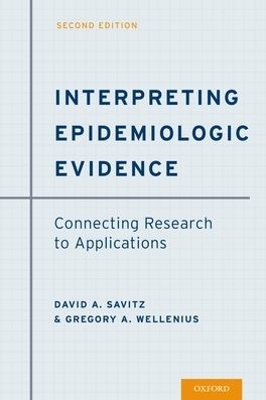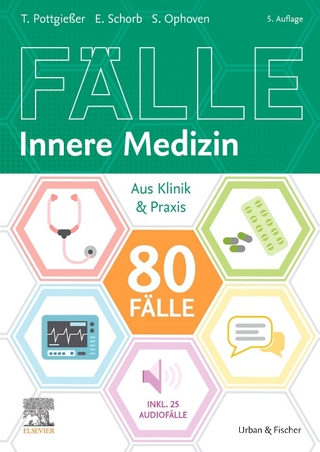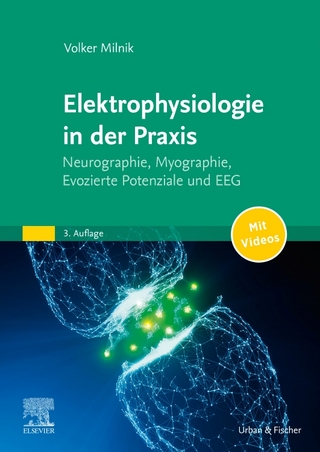
Interpreting Epidemiologic Evidence
Oxford University Press Inc (Verlag)
978-0-19-024377-7 (ISBN)
Epidemiology, the so-called "science of public health," has undergone a boom in the last decade as public interest and engagement in population health has skyrocketed. While this boom has done much to spark advances in the technology of epidemiology, it has also made it harder for those who want to use epidemiology to guide policy and clinical practice to fully appreciate the meaning of the research findings.
Interpreting Epidemiologic Evidence offers those who have had an introductory course in epidemiology the knowledge they need to make clear connections from research findings to practical applications. Written in clear and lively prose, it empowers students at all levels to evaluate a study's design, implementation, and ultimate findings, giving the guidance needed to apply the information appropriately. Liberal use of practical examples serves both to illustrate core concepts and to motivate readers to think critically about the causal connections that population health studies aim to explore.
Completely revised and updated, this new edition of Interpreting Epidemiologic Evidence is an invaluable core text for both epidemiologists in training and practitioners across other disciplines with even an introductory knowledge of epidemiology.
David A. Savitz, PhD, is Professor of Epidemiology and Obstetrics and Gynecology at Brown University. He has held leadership positions at the University of North Carolina (Chair of the Department of Epidemiology) and at Brown University (Vice President for Research), as well as in a number of professional organizations. His research is focused primarily on reproductive and environmental epidemiology. He was elected to the National Academy of Medicine in 2007. Gregory A. Wellenius, ScD, is Associate Professor of Epidemiology at Brown University. His research focuses on the effects of our environment on cardiovascular health, with an emphasis on the adverse health effects of air pollution and the built environment. He has taught advanced graduate courses in epidemiologic methods, provided invited expert testimony before the US House of Representatives and US Senate, and mentored a number of undergraduate, medical, masters, and doctoral students.
Interpreting Epidemiologic Evidence: Connecting Research to Applications
1. Introduction
Synopsis
Learning Objectives
Perspective
Approach to the Evaluation of Evidence
Organization of Book
2. The Nature of Epidemiologic Evidence
Synopsis
Learning Objectives
Goals of Epidemiologic Research
Measurement of Causal Relations Between Exposure and Disease
Applications of Epidemiologic Research
Framework for Examining Epidemiologic Evidence
Relationship of Epidemiology to Health Policy
Exercise: Critical Assessment of Study Methods, Results, and Applications
3. Causal Diagrams for Epidemiologic Inference
Synopsis
Learning Objectives
Introduction
Causal Diagrams in Epidemiology
Purpose and Terminology
DAGs Encode Our Assumptions
Statistical Associations
Connection to Data Analyses
Depicting Passage of Time
Direct vs. Indirect Effects
Concluding Thoughts
Recommended Additional Readings
Exercise: Application of Causal Diagrams for Epidemiologic Inference
4. Strategy for Drawing Inferences from Epidemiologic Evidence
Synopsis
Learning Objectives
Conceptual Framework for the Evaluation of Error
Estimation of Measures of Association
Systematic Evaluation of Sources of Error
Objective Evaluation of Sources of Error
Identifying the Most Important Sources of Error
Specifying Bias Scenarios
Exercise: Specifying Scenarios of Bias
5. Confounding I: Theoretical Considerations
Synopsis
Learning Objectives
Definition
Identifying Potential Confounders
Traditional Approach to Assessing Confounding
Modern Approach to Assessing Confounding
Inappropriate Adjustments
Assessing the Direction and Magnitude of Potential Confounding
Methods of Controlling Confounding
Randomization
Selection of Study Setting Free of Confounding
Restrict Study Groups to Enhance Comparability
Statistical Adjustment for Confounding
Recommended Additional Readings
Exercise: Conceptual Basis of Confounding
6. Confounding II: Practical Considerations
Synopsis
Learning Objectives
Evaluating the Presence and Impact of Confounding
Specifying Scenarios of Confounding
Assessing Whether Confounding is Present
Consider Potential for Complete Confounding
Assess Consequences of Inaccurate Confounder Measurement
Applying Knowledge of Confounding Based on Other Studies
Assessing Confounding When Risk Factors are Unknown
Dose-Response Gradients and Potential for Confounding
Integrated Assessment of Potential Confounding
Exercise: Connecting Conceptual and Statistical Assessment of Confounding
7. Selection Bias and Confounding Resulting from Selection in Cohort Studies
Synopsis
Learning Objectives
Study Designs
Definition and Examples of Selection Bias
Selection Bias Versus Confounding
Evaluation of Bias in Cohort Studies
Compare Those Included to Those Not Included
Compare Disease Rates Among Unexposed to External Populations Assess Whether Expected Patterns of Disease are Present
Assess Pattern of Results in Relation to Markers of Susceptibility to Bias Due to Participant Selection
Assess Rates for Diseases Known Not to Be Affected by the Exposure
Integrated Assessment of Potential for Bias in Cohort Studies
Exercise: Assessment of Bias Due to Selection in Cohort Studies
8. Selection Bias in Case-Control Studies
Synopsis
Learning Objectives
Control Selection
Participant Selection in Case-Control and Cohort Studies
Selection of Controls from the Source Population
Coherence of Cases and Controls
Evaluation of Selection Bias in Case-Control Studies
Temporal Coherence of Cases and Controls
Discretionary Health Care of Cases and Controls
Compare Exposure Prevalence in Controls to an External Population
Determine Whether Exposure Prevalence Varies as Expected Among Controls
Examine Markers of Potential Selection Bias in Relation to Measures of Association
Adjust Measures of Association for Known Sources of Non- Comparability
Determine Whether Established Associations Can Be Confirmed
Integrated Assessment of Potential for Selection Bias in Case-Control Studies
Exercise: Assessing Selection Bias in Case-Control Studies
9. Bias Due to Loss of Study Participants
Synopsis
Learning Objectives
Conceptual Framework for Examining Bias Due to Loss of Study Participants
Evaluation of Bias Due to Loss of Study Participants
Characterize Nonparticipants
Consider Gradient of Difficulty in Recruitment
Stratify Study Base by Markers of Participation
Impute Information for Nonparticipants
Integrated Assessment of Potential for Bias Due to Loss of Study Participants
Exercise: Examining Implications of Non-Participation
10. Measurement and Classification of Exposure
Synopsis
Learning Objectives
Introduction
Ideal Versus Operational Measures of Exposure
Biologically Relevant Exposure
Temporally Relevant Exposure
Optimal Level of Exposure Aggregation
Comparison of Optimal to Operational Measures of Exposure
Does Exposure Misclassification Differ by Disease Status?
Definitions
Mechanisms of Differential Exposure Misclassification
Evaluation of Exposure Misclassification
Compare Routine Measure to Superior Measures
Examine Multiple Indicators of Exposure
Examine Subsets of the Population with Differing Exposure Data Quality
Evaluate Known Predictors of Exposure
Evaluate Known Consequences of Exposure
Examine Dose-Response Gradients
Evaluate Whether Exposure Misclassification Differs by Disease Status
Identification of Subgroups with Nondifferential Exposure Misclassification
Integrated Assessment of Bias Due to Exposure Misclassification
Exercise: Assessing the Presence and Impact of Exposure
Misclassification
11. Measurement and Classification of Disease
Synopsis
Learning Objectives
Framework for Evaluating Disease Misclassification
Sources of Disease Misclassification
Impact of Differential and Nondifferential Disease Misclassification
Evaluation of Disease Misclassification
Verify Diagnostic Accuracy for Subset of Study Participants
Examine Results Across Levels of Diagnostic Certainty
Evaluate Alternate Methods of Disease Grouping
Determine Whether Misclassification is Differential by Exposure Status
Create Subgroups with Accurate Ascertainment or Non-Differential
Underascertainment
Restrict Inference to Disease Outcome That Can Be Ascertained Accurately
Integrated Assessment of Potential for Bias Due to Disease Misclassification
Exercise: Assessing the Presence and Impact of Disease Misclassification
12. Random Error
Synopsis
Learning Objectives
Nature of Random Variation
Sequential Approach to Considering Random and Systematic Error
Special Considerations in Evaluating Random Error in Observational Studies
Statistical Significance Testing
Interpretation of Confidence Intervals
Multiple Comparisons and Related Issues
Integrated Assessment of Random Error
Exercise: Assessing Random Error
13. Integration of Evidence Across Studies
Synopsis
Learning Objectives
Introduction
Systematic Evidence Reviews
Data Pooling and Comparative Analyses
Meta-Analysis
Interpreting Consistency and Inconsistency Among Studies
Inconsistent Findings
Consistent Findings
Evolution of Epidemiologic Research
Integrated Assessment from Combining Evidence Across Studies
Exercise: Interpreting Evidence from a Collection of Studies
14. Characterization and Communication of Conclusions
Synopsis
Learning Objectives
Presenting Clear, Objective, and Informed Conclusions
Applications of Epidemiology
Integration of Epidemiologic Evidence with Other Information
Identification of Key Concerns
Controversy over Interpretation
The Case Against Algorithms for Interpreting Epidemiologic Evidence
Exercise: Communicating Summary Assessment of Epidemiologic Evidence
| Erscheinungsdatum | 25.05.2016 |
|---|---|
| Verlagsort | New York |
| Sprache | englisch |
| Maße | 231 x 155 mm |
| Gewicht | 363 g |
| Themenwelt | Studium ► 2. Studienabschnitt (Klinik) ► Anamnese / Körperliche Untersuchung |
| Studium ► Querschnittsbereiche ► Epidemiologie / Med. Biometrie | |
| Studium ► Querschnittsbereiche ► Prävention / Gesundheitsförderung | |
| ISBN-10 | 0-19-024377-5 / 0190243775 |
| ISBN-13 | 978-0-19-024377-7 / 9780190243777 |
| Zustand | Neuware |
| Informationen gemäß Produktsicherheitsverordnung (GPSR) | |
| Haben Sie eine Frage zum Produkt? |
aus dem Bereich


